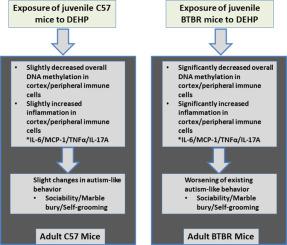Progress in Neuro-Psychopharmacology and Biological Psychiatry ( IF 5.6 ) Pub Date : 2021-01-23 , DOI: 10.1016/j.pnpbp.2021.110249 Ahmed Nadeem 1 , Naif O Al-Harbi 1 , Sheikh F Ahmad 1 , Khalid Alhazzani 1 , Sabry M Attia 1 , Sary Alsanea 1 , Ali Alhoshani 1 , Hafiz M Mahmood 1 , Ali S Alfardan 1 , Saleh A Bakheet 1

|
Epigenetic modifications are known to play a crucial role in the behavioral modifications through regulation of gene expression. Environmental factors are known to regulate genetic transcription through DNA methylation which is one of the mechanisms of epigenetic modification. Di-2-ethylhexyl phthalate (DEHP) is one of the most abundant phthalate plasticizers in day-to-day products. Prenatal/postnatal DEHP administration has been reported to cause inflammation as well as behavioral dysregulation, however it is not known if exposure to DEHP during juvenile stage affects peripheral/neuronal inflammation and autism-like symptoms in BTBR mice at adulthood. This study investigated effect of DEHP exposure during juvenile period on DNA methylation (global DNA methylation/DNMT1 expression) and inflammation (IL-17A, IL-6, MCP-1, TNF-α) in CD4 + T cells/CD11c + DCs and cortex, and autism-like symptoms (three-chambered sociability test, self-grooming and marble burying test) in asocial BTBR and social C57 mice at adulthood. Our data reveal that BTBR mice exposed to DEHP during juvenile period have hypomethylated DNA/DNMT1 expression in CD11c + DCs and cortex as compared to vehicle-exposed BTBR mice. It was associated with upregulated inflammation in periphery [plasma IL-6/IL-17A, CD11c + DCs (IL-6/MCP-1/TNF-α), and CD4+ T cells (IL-17A)] and cortex (IL-6, MCP-1, TNF-α), and aggravation in autism-like symptoms in DEHP-treated BTBR mice. These data propose that exposure of DEHP during juvenile period may affect autism-like behavior and inflammation in BTBR mice at adulthood through epigenetic regulation. Therefore, underlying genetic predisposition may play a crucial role in worsening of autistic symptoms in ASD subjects in adulthood if they are exposed to environmental pollutants such as DEHP during juvenile period.
中文翻译:

由于 DNA 低甲基化和脑和全身免疫细胞的炎症增强,在幼年期暴露于增塑剂邻苯二甲酸二(2-乙基己基)酯会加剧成年 BTBR T + tf/J 小鼠的自闭症样行为
已知表观遗传修饰通过调节基因表达在行为修饰中起关键作用。已知环境因素通过 DNA 甲基化调节基因转录,这是表观遗传修饰的机制之一。邻苯二甲酸二-2-乙基己酯 (DEHP) 是日常用品中含量最丰富的邻苯二甲酸酯增塑剂之一。据报道,产前/产后 DEHP 给药会引起炎症和行为失调,但尚不清楚在幼年期接触 DEHP 是否会影响成年 BTBR 小鼠的外周/神经元炎症和自闭症样症状。本研究调查了青少年时期 DEHP 暴露对 DNA 甲基化(整体 DNA 甲基化/DNMT1 表达)和炎症(IL-17A、IL-6、MCP-1、TNF-α)在 CD4 + T 细胞/CD11c + DCs 和皮质中,以及成年期非社交 BTBR 和社交 C57 小鼠的自闭症样症状(三室社交测试、自我修饰和大理石掩埋测试)。我们的数据显示,与载体暴露的 BTBR 小鼠相比,在幼年期暴露于 DEHP 的 BTBR 小鼠在 CD11c + DCs 和皮质中具有低甲基化的 DNA/DNMT1 表达。它与外周炎症[血浆 IL-6/IL-17A、CD11c + DCs (IL-6/MCP-1/TNF-α) 和 CD4+ T 细胞 (IL-17A)] 和皮质 (IL- 6、MCP-1、TNF-α)和 DEHP 处理的 BTBR 小鼠中自闭症样症状的加重。这些数据表明,在幼年期接触 DEHP 可能通过表观遗传调控影响成年期 BTBR 小鼠的自闭症样行为和炎症。所以,



























 京公网安备 11010802027423号
京公网安备 11010802027423号